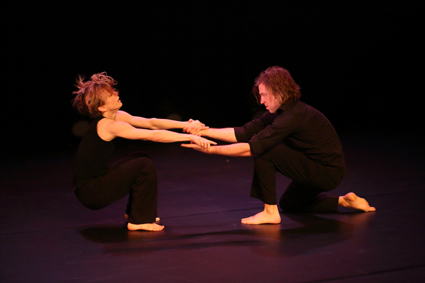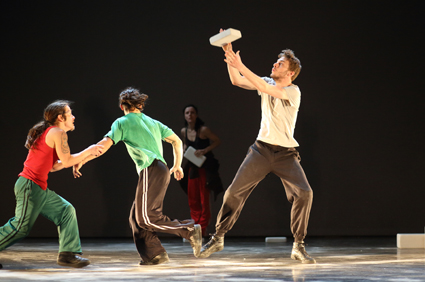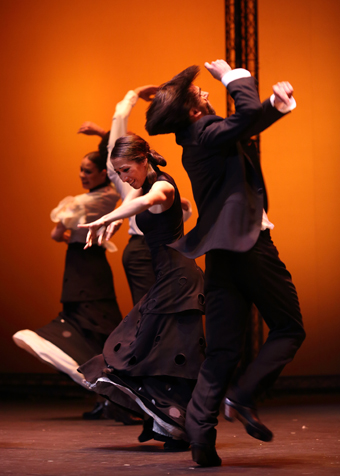the body, eloquent, risk-taking & violent
anne thompson: dance, adelaide festival 2013

Louise Lecavalier, Patrick Lamothe, Children
photo Tony Lewis, courtesy Adelaide Festival 2013
Louise Lecavalier, Patrick Lamothe, Children
THE 2013 ADELAIDE FESTIVAL’S STRONG DANCE PROGRAM INCLUDED SYLVIE GUILLEM, LOUISE LECAVALIER, WIM VANDEKEYBUS’ ULTIMA VEZ, A FLAMENCO PROGRAM DIRECTED BY CARLOS SAURA AND THE PREMIERE OF A WORK BY EMERGING AUSTRALIAN CHOREO-GRAPHER LARISSA MCGOWAN. ANNE THOMPSON LOOKS AT THREE OF THESE, REFLECTING ON DANCE LANGUAGES, SKILL AND ENDURANCE AND ISSUES OF CULTURAL AND AESTHETIC FRAMING. (SEE P11 FOR RESPONSES TO GUILLEM AND MCGOWAN, EDS.)
louise lecavalier
Louise Lecavalier is formidable at 50—muscular, assured, capable of great nuance and completely at the centre of both works, Children and A Few Minutes of Lock. There is familiar vocabulary from Lecavalier’s time with Édouard Lock’s Canadian company La La Human Steps: the primal high crawl at speed, the decisive manipulation of an object (in this case pillows and a pole), fragments of ballet (fancy foot work, soft arms, stated arabesques), high velocity horizontal and vertical leaps, gestural partner work (expressing both tenderness and violence), forward and rewind, all performed with throw-away casualness.
Children is set against musical tracks that locate the piece in Lecavalier’s era. We move from the likes of Leonard Cohen to Miles Davis to Billie Holliday (to name a few) through to a Puccini climax; all songs of love and longing. Then there is the sound of children playing and later crying. The program note points us to conceive of the dancers (and ourselves) as children with the longings of children. This longing is represented with great irony and control. The impact of the determined and exact physicality in the piece has more to do with an experience of endurance and stamina. There is something poignant in that determination in the face of want.
A Few Minutes of Lock has Lecavalier suspended and moving in relation to two men. Occasionally they break out into moves of their own. There is dainty peripheral fluttering of feet and hands, daring catches, huge propulsion from small impetus. This is not about the simple meaning of weight and momentum. There is showmanship here, flair, even when the movement is again throw-away. Meaning is again produced in the assured relentlessness of the display. The intimate venue allowed us to breathe with Lecavalier, not just watch her convincing puppet-like performance. The music of Iggy Pop was featured in this piece. I remembered La La La Human Steps collaborating with David Bowie. There’s something of the rock star in Lecavalier strutting her stuff and I can’t help but admire her tenacity.
ultima vez

Ultima Vez, What the Body Does Not Remember
photo Tony Lewis, courtesy Adelaide Festival 2013
Ultima Vez, What the Body Does Not Remember
What the Body does not remember is a recreation of the seminal 1987 work. I enjoyed the disjunction between choreographic methods I associate with the late 70s and 80s (task work with objects and sound familiar to me from American postmodern dance) and these strong and varied European bodies (the favoured look of contemporary dancers now). The work is still charged. But when I leave my heart is pounding. I am disquieted by the European sensibility applied to this task work, taking it to an extreme both in duration and in terms of skill and danger. The sporty playfulness evident in American task work and a form like contact improvisation is absent.
Images surface despite the concreteness of the tasks. Lying, ‘sleeping’ bodies react/shift in response to loud noise, a dancer drumming a miked table (later I think of this as a guard and prisoners). Then dancers seek to traverse the space on different sized blocks using them as stepping stones. The game gets increasingly complex and dangerous. The blocks are thrown and caught (near misses occur); complex, precarious structures are built and balanced on, dancers leap and run and change position with each other (the image for me is of children playing in rubble). The skill of the performers is breathtaking.
Then we watch a long sequence of putting on and stealing towels and coats. The benign image of wrapping one’s hair in a towel and having the towel stolen is troubled by the recurring image of putting on a coat only to have it taken from you.
Then the games get gendered. A man tries to touch a woman’s knee; another man tries to touch a woman’s hair. The women stamp to rid themselves of the attention. The pursuit is relentless. This turns into a disturbing game of men feeling women’s bodies while the women stand legs wide, arms stretched out at shoulder level, reminiscent of the posture and action of security checks. The women move to escape and are caught. They return again and again to stand outstretched, available to be searched. The image drifts towards and away from the erotic and the pornographic—my sense of the agency of the women determining my response.
A more innocent game of orientation follows—a man sitting on a laid-down chair changing positions and a woman sitting on a chair standing up mirroring his moves. This evolves into a series of photos with the whole company. Three solos by dancers blowing a feather up and letting it float down allow us to rest in some depiction of innocence.
There are other structures but the finale is a game of one dancer stamping near another who is lying down. The one lying responds by curling and uncurling. As the pace, duration and proximity of the stamping increase so does the danger. The stamping is fierce. There are also solos of stamping apart from the lying bodies. This extended sequence is violent, eloquently violent.
The performers do not use facial expressions to suggest what our attitude might be to what is happening. Meaning is all in the movement. This is performance as finally brutal. We are lured there by the pleasure of watching the performers’ skill at tasks and games.
carlos saura

Flamenco Hoy
photo Tony Lewis, courtesy Adelaide Festival 2013
Flamenco Hoy
This was a strange ‘concert’ in the grand Festival Theatre. The evening consisted of discrete items—pieces with the company of dancers, solos created by choreographers Rafael Estévez and Valeriano Paños, guitar solos and accompaniment by Antonio Rey sometimes with other musicians, piano solos and accompaniment by Chano Dominguez and singing by Sandra Carrasco, Blas Córdoba and Israel, sometimes alone and sometimes as accompaniment to dancing. Costumes are changed, screens are moved to delineate space and lights in bold colour illuminate each piece. The entire event is directed by Carlos Saura who so masterfully used flamenco as a theatrical language on film in the 1980s with Bodas de Sangre (Blood Wedding), Carmen and El amor brujo. Here it is hard to discern his hand. I notice that the producer tours rock groups and opera productions. These aesthetic and production values dominate and prevent consistent immersion in the physicality, rhythm and sounds of this form.
The skill of all the artists is exquisite. I find myself relishing the moments which seem improvised. The solos have that feel. I am reminded of tap or hip hop solos, of someone dancing at the peak of their skill level and in response to rhythm and music. The singing has a rawness of tone that is thrilling, close to calling or wailing. The section where a number of solo dancers worked with different solo singers finally drew me in to some space of performance not constrained by the production. The engagement between the singer and dancer was electric and robust like a great jazz duet.
I read in the program that the Flamenco vocabulary used by these choreographers has been modified with jazz and contemporary influences, even ballet. I could sense that. There was an unexpected looseness to the bodies at times, a breaking away from and returning to the strict Flamenco frame. There was also ballet virtuosity. I could hear the influence of 20th century composers such as Bartók in the piano compositions and hints of jazz in the guitar pieces. All of these developments were enticing.
I am not versed in this dance style so I found myself seeking cues as to how to watch any differently than as a tourist, as somehow separate but with investment in the piece delivering something I want; in this case, some drama. The production spoke of cultural trading in a way I rarely see in international festivals these days; the products of a culture delivered in a commercial form but made ‘contemporary’ as befitting an arts festival through incorporation of recognisable cultural influence from some cultural power (in this case, the United States). I am used to trade deals being less visible and thus making the work more comfortable for me to be part of as a member of an ‘educated arts audience.’ This was a timely reminder of what is always at stake even when I choose not to notice.
Adelaide Festival 2013: Louise Lecavalier, Children, choreographer Nigel Charnock, dancers Louise Lecavalier, Patrick Lamothe; A Few Minutes of Lock, choreographer Édouard Lock (excerpts from Salt and 2), dancers Louise Lecavalier, Keir Knight, Patrick Lamoth, Space Theatre, March 6-9; Ultima Vez, What the Body Does Not Remember, direction, choreographer, scenography Wim Vandekeybus, Dunstan Playhouse, March 7-10; Flamenco Hoy, director Carlos Saura; Festival Theatre, Adelaide, March 15, 16
RealTime issue #114 April-May 2013 pg. 12






